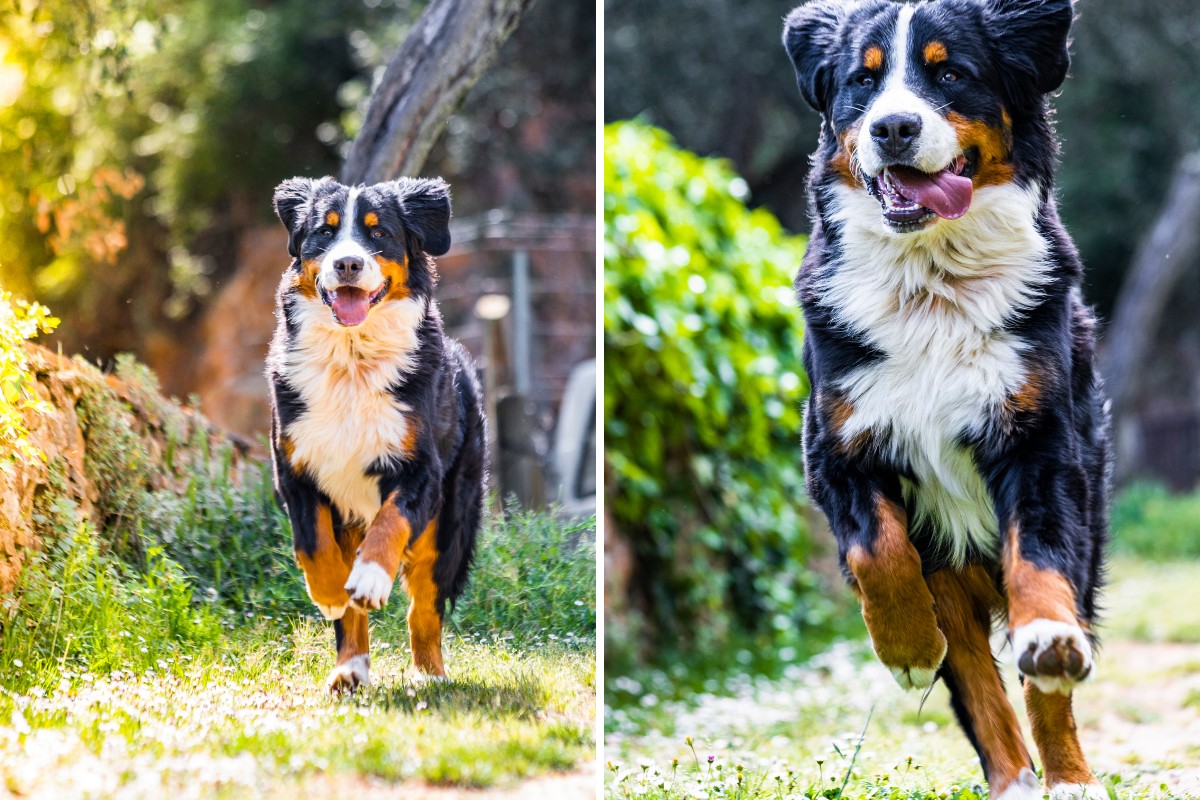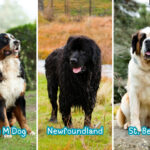 6 Nov
6 NovAre Bernese Mountain Dogs High Energy?
If you’re picturing a Bernese Mountain Dog, you might imagine a serene giant with a tri-color coat that’s as plush as the majestic Swiss mountains. But do these lovable dogs match their calm appearance when it comes to energy, or are they bustling with high-powered vigor?
No, Bernese Mountain Dogs are not typically high-energy dogs. They possess a moderate energy level that complements their origin as farm dogs adept at drafting and herding. These dogs are known for their calm and steady nature, which balances well with daily walks and regular playtime.
Understanding Berners’ potential energy levels is crucial for anyone considering welcoming one into their life. It can mean the difference between a harmonious home and a little too lively. As a seasoned dog parent, I’ve seen that while some breeds are content to lounge, others thrive on action and activity.
Bernese Mountain Dogs have a storied past that hints at their energy needs, and today we’re going to unpack what that means for you as a potential owner. It’s not just about how much they’ll pull on the leash; it’s about knowing what fuels their happiness and how that aligns with your lifestyle.
So, are Bernese Mountain Dogs high-energy? Let’s get to the heart of this question, and provide you with the insights you need to understand the vivacious spirit of these mountainous companions.

Understanding Bernese Mountain Dog Temperament
Understanding the temperament of a Bernese Mountain Dog (BMD) is key to appreciating this breed’s energy levels. Let’s delve into the personality traits, historical background, and genetic factors that shape the character of these gentle giants.
Overview of the Breed’s Personality Traits
Bernese Mountain Dogs are known for their affectionate nature and loyalty to their families. They typically display a calm and composed demeanor, showing patience and a friendly disposition. Though they may be reserved around strangers, a well-socialized Berner is approachable and gentle.
They are also particularly good with children, often displaying a protective instinct. While they may not exhibit the boundless energy seen in some breeds, they are certainly not couch potatoes and will enjoy being active participants in household activities.
The History of Bernese Mountain Dogs and the Work They Were Bred For
Originating from the Swiss Alps, specifically the canton of Bern, these dogs were bred for a multitude of tasks on farms. Their ancestors were brought into Switzerland by the Romans over 2,000 years ago. Historically, BMDs were used as draft animals, pulling carts to market, herding cattle, and serving as loyal companions to the farmers.
This working heritage endows them with the strength and stamina necessary for labor-intensive tasks, rather than the frenetic energy suited for high-speed or all-day endurance activities.
How Genetics Play a Role in Their Energy Levels
The genetic makeup of a Bernese Mountain Dog has been fine-tuned through generations of selective breeding for specific roles that require a balanced energy level. The physicality of their historical work—like pulling carts—demanded strength and endurance more than speed or agility.
Their genes carry the blueprint for a dog with a moderate and manageable energy level, one that is conducive to bursts of activity interspersed with periods of rest. Modern-day BMDs retain these genetic traits, which influence not just their physical abilities but their temperaments as well.
Factors That Affect Energy Levels in Bernese Mountain Dogs
Bernese Mountain Dogs, like all breeds, have energy levels that are influenced by a variety of factors. Understanding these can help you ensure that your Berner lives a balanced and fulfilling life. Let’s look at how age and life stages, diet and nutrition, health and medical conditions, as well as their environment and lifestyle, play pivotal roles in determining the vigor of a Bernese Mountain Dog.
1. Age and Life Stages
The energy levels of Bernese Mountain Dogs change significantly over their lifetime. Puppies, with their boundless curiosity and growing bodies, have spurts of high energy and require plenty of playtime. As they grow into adults, their energy levels tend to plateau at a more moderate pace.
Senior Berners often slow down considerably and may prefer leisurely walks to the more vigorous play of their youth. Adapting activities to suit their age and life stage is key in providing a healthy lifestyle for a Berner.
2. Diet and Nutrition’s Impact
A Bernese Mountain Dog’s diet plays a crucial role in their overall energy and vitality. A balanced diet with the right amount of protein, fats, and carbohydrates can help maintain optimal energy levels.
High-quality dog food tailored to their specific size, age, and activity level can keep them from becoming lethargic or, conversely, overly energetic due to excessive calorie intake. Consistency in feeding times and avoiding overfeeding with treats is also important to keep their energy levels stable.
3. Health and Medical Conditions
Health issues can significantly affect the energy levels of a Bernese Mountain Dog. Conditions such as hip dysplasia, a common ailment in larger breeds, can lead to pain and decreased activity. Other health concerns, like hypothyroidism, can also affect their metabolism and energy. Regular check-ups with a veterinarian can catch and manage health issues before they impact your Berner’s energy levels too severely.
4. Dog’s Environment and Lifestyle
The living environment and lifestyle of a Bernese Mountain Dog will shape their daily energy output. Dogs that have ample space to roam and play tend to exhibit a more consistent energy level. Conversely, a BMD living in a small space may have pent-up energy or seem less energetic if they’re not getting adequate exercise.
Additionally, the amount of interaction and stimulation a dog receives through training, play, and companionship can also encourage a healthy expression of energy.

Exercise Needs of Bernese Mountain Dogs
Bernese Mountain Dogs require a balanced exercise regimen that takes into account their size, energy level, and physical capabilities. By incorporating the right routines and activities, you can keep your Berner in excellent health and spirits. Here’s a breakdown of their exercise needs, activity suggestions, and seasonal considerations.
Recommended Exercise Routines for Bernese Mountain Dogs
An adult Bernese Mountain Dog typically benefits from at least 30 minutes to an hour of exercise daily. This can be split into two sessions—one in the morning and one in the evening—to keep them stimulated without overexertion. Puppies and young Berners have more energy to burn and can often handle a bit more activity, while seniors may require shorter, more gentle sessions.
The recommended exercise routine should include:
- A brisk walk or a leisurely stroll for both physical and mental stimulation.
- Playtime in a fenced yard or open space, such as fetch or tug-of-war, to engage their muscles and minds.
- Training sessions that incorporate obedience work or agility exercises, tailored to their learning level and physical abilities.
Different Types of Activities Suitable for Different Energy Levels
The Bernese Mountain Dog’s moderate energy level makes them versatile in the types of activities they can enjoy:
- Low-intensity activities: For Berners with lower energy or for older dogs, activities like leisurely walks, gentle play sessions, or nose work games can be sufficient.
- Moderate-intensity activities: Hiking on gentle trails, casual swimming, and interactive games like hide-and-seek with treats or toys are great for dogs with a moderate energy level.
- High-intensity activities: For younger, more active Berners, activities such as longer hikes, advanced training sessions for dog sports, or even cart-pulling (which ties back to their heritage) can be both appropriate and enjoyable.
Seasonal Considerations for Exercising Your BMD
Bernese Mountain Dogs have thick, long coats that make them well-suited to colder climates, but they can be prone to overheating in warm weather:
- During summer: Exercise your Berner in the cooler parts of the day, provide plenty of water, and avoid strenuous exercise on hot days. Swimming can be a great summer activity, as it allows them to cool off while getting a workout.
- In winter: They thrive in colder temperatures, but it’s still important to protect their paws from ice and salt and to ensure they’re not outside for too long during extreme cold. Winter sports like skijoring can be a fun activity for both pet and owner.
Training and Mental Stimulation for Bernese Mountain Dogs
Just as our bodies need regular exercise to stay healthy, our minds require challenges to stay sharp and engaged. This is equally true for Bernese Mountain Dogs, whose intelligence and work-oriented history make mental stimulation just as crucial as physical activity. Here’s why keeping their minds active is important, along with some tips on training and games that can help.
Why Mental Stimulation is as Important as Physical Exercise
Mental stimulation is essential for Bernese Mountain Dogs to prevent boredom, reduce the likelihood of developing anxiety and destructive behaviors, and satisfy their natural instincts and intelligence. Engaging their minds can also help tire them out in a way that physical exercise alone cannot, leading to a more balanced and contented dog.
Moreover, mental stimulation can:
- Improve problem-solving skills.
- Increase the bond between dog and owner.
- Help maintain cognitive function into old age.
Training Tips to Manage and Channel High Energy Positively
When it comes to training your Berner, positive reinforcement methods work best. These dogs are sensitive and respond well to rewards-based training. Here are some tips:
- Use short, engaging training sessions to keep their attention.
- Incorporate training into playtime to manage their energy and teach them new skills simultaneously.
- Train in a variety of environments to expose them to different stimuli.
- Always end on a positive note to keep them eager for the next session.
Training exercises that can also serve as mental workouts include:
- Obedience training for commands like sit, stay, come, and heel.
- Agility training, even if just done informally in the backyard, can be a fun way to engage their minds and bodies.
- Nose work, which taps into their instinctual skills, can be done with simple hide-and-seek games using treats or toys.
Puzzle Toys and Games to Keep Your Berner Engaged
Puzzle toys are an excellent way to keep your Bernese Mountain Dog mentally stimulated, especially when they have to stay indoors. There are various toys and games available that can challenge them, such as:
- Treat-dispensing toys that require manipulation to release food rewards.
- Interactive puzzles where they must move pieces to discover hidden treats.
- Hide-and-seek toys that encourage them to use their noses and problem-solving skills.
- You can also create DIY games like scattering kibble in the backyard for them to sniff out or creating an obstacle course for them to navigate. Even teaching them new tricks or commands can be a fun way to engage their minds.




